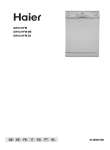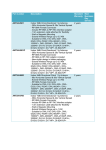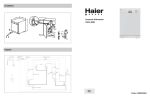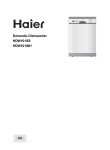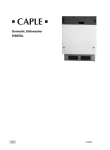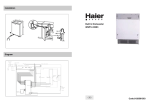Download Installation Diagram Domestic dishwasher Di604
Transcript
Installation Domestic dishwasher Di604 Diagram The symbol on the product or on its packaging indicates that this product may not be treated as household waste. Instead it shall be handed over to the applicable collection point for the recycling of electrical and electronic equipment. By ensuring this product is disposed of correctly, you will help prevent potential negative consequences for the environment and human health, which could otherwise be caused by inappropriate waste handling of this product. For more detailed information about recycling of this product, please contact your local city office, your household waste disposal service or the shop where you purchased the product. GB 012050 Safety Is a Good Habit to Get Into GB NOTICE * During installation, the power supply cord must not be exces- Carefully read the instructions contained in this manual, as they sively or dangerously bent or flattened; * If the appliance is not operated properly or maintenance must provide important information which is essential to safe and proper installation, use and maintenance of the appliance. Close-up View (Interior) GB be performed, disconnect the appliance from the power supply. Keep detergents out of the reach of children, who must also be This appliance complies with the following EEC directives: kept away from the dishwasher when it is open. - This appliance cannot be installed outdoors, not even if the area - 73/23/EEC of 19/02/73 ( Low Voltage) and subsequent modifications; in which it is installed is covered by a roof; it is also very dangerous to leave it exposed to the rain and elements. - 89/336/EEC of 03/05/89 (Electromagnetic Compatibility) and - Do not touch the heating element during or after a wash cycle. - Do not lean or sit on the door when it is open ,as this could subsequent modifications. - Carefully dispose of the packing material. overturn the dishwasher. - If the appliance malfunctions, turn off water supply to the appli- - After removing the packing, check to make sure that the appliance is not damaged. If in doubt, contact a qualified professional. ance and disconnect the plug from the wall socket. Then, consult the section entitled, "Troubleshooting". If you cannot solve - The dishwasher must only be used by adults for the washing of household dishes and cooking utensils. the problem, contact a service center. - Only specialized personnel are authorized to make repairs. - Fundamental rules to follow when using the appliance: * Never touch the dishwasher when barefoot or with wet hands - Appliances which are no longer being used must be made inoperable by cutting the power supply cord and removing the door or feet; * We discourage the use of extension cords and multiple sock- lock. - If the supply cord is damaged, it must be replaced by the ets; manufacture, its service agent of similarly qualified persons in order to avoid a hazard. Close-up View (control panel) D B A B C D Upper Rack Rack Height Adjustor Top Spray Arm Lower Rack E F G H Bottom Spray Arm Washing Filter Detergent and Rinse Aid Dispenser Salt Container Cap A Technical characteristics C A B C D ON-OFF Button ON-OFF Light Width 60 cm Depth 58 cm Height 82 cm 12 standard place settings Capacity Cycle Select Button Mains water pressure 0.03-0.6MPa Cycle Indicator Light 220-240V~ 50Hz Power voltage 2100W Total absorber power .1. .2. Salt Detergent and Rinse Aid GB Salt Adjusting Salt Consumption The hardness of the water varies from place to place. If hard The dishwasher is designed to allow for adjusting the amount of salt consumed based on the hardness of the water used. This is water is used in the dishwasher, deposits will form on the dishes and utensils. intended to optimize and customize the level of salt consumption so that it remains at a minimum. The appliance is equipped with a special softener that uses a salt specifically designed to eliminate lime and minerals from To adjust salt consumption, proceed as follows: GB Detergent Rinse Aid Detergent specifically intended for use with dishwashers must be used. The dispenser must be refilled before the start of each This product makes dishes sparkle and helps them to dry without spotting. The dispenser is located on the inside panel of the wash cycle following the instructions provided in the "Wash Cycle Table. "The detergent dispenser is located on the inside panel door and should be filled after every 80 wash cycles (or when the "low rinse aid" indicator light comes on for those models the door. with this feature). the water. Loading the detergent Loading the Rinse Aid To open the "A" cover on the dispenser, press the "B" button. The detergent for the wash cycle should be poured into the "C" Loading the Salt into the Softener Regardless of the type of detergent dispenser installed on your appliance, you must proceed as indicated below when loading compartment. After the detergent has been placed in the dispenser, close the Always use salt intended for use with dishwashers. The salt container is located beneath the lower rack and should the rinse aid. To open the dispenser, turn the "C" cap in an anti-clockwise cover and press down until it clicks in place. direction and then pour in the rinse aid, making sure not to overfill. The amount of rinse aid used for each cycle can be regulated by be filled as follows: - Remove the lower rack and then unscrew and remove the cap from the salt container; - If you are filling the container for the first time, fill it with water; turning the "F" dose adjustor ,located beneath the "C" cap, with a screwdriver. There are 6 different settings; the normal dosage B setting is 3. - Place the end of the funnel (supplied) into the hole and introduce about 2 kg of salt. It is normal for a small amount of water to come out of the salt container. - Carefully screw the cap back on. Important - Unscrew the cap from the salt container; Proper dosage of the rinse aid improves drying. - There is a ring on the container with an arrow on it (see figure to the side), - If necessary, rotate the ring in an anti-clockwise direction from If drops of water remain on the dishes or spotting occurs, the dosage adjustor should be turned to a higher setting. If the dishes have white streaks, turn the dosage adjustor to a lower setting. the "-" setting towards the "+" sign, based on the hardness of the water being used. It is recommended that adjustments be made in accordance with the following schema: C A Water Hardness The salt container should be filled after about every 10-12 wash cycles. C Clark degrees ˚dH mmol/l Selector position 014 MNT MNIT L Salt Autonomy consumption (cycles/2kg) (Grams/cycle) M Notice: To facilitate closing the cover, remove any excess detergent on the edges of the dispenser. L F To prevent the formation of rust, load the salt just before beginning a wash cycle. NQPS NUQQ NIUQIQ ?J? OM SM PSTN QRUV QIRUIV jba QM QM ?H? SM OR [TN .3. [UV [UIV .4. Loading the Dishwasher GB Starting the Appliance GB Starting a wash cycle If you forget to load some of the dishes... food debris to prevent the filter from becoming clogged, which results in reduced performance. After having completed all of the installation steps in the preceding paragraphs, turn on the water to the unit, partially open the The wash cycle can be interrupted by opening the door carefully If the pots and pans have baked-on food that is extremely hard to remove, we recommend that they be allowed to soak before door of the dishwasher, and press the ON-OFF button "A" located on the control panel. The "B" indicator light will come on. they are washed. This will eliminate the need for extra wash cycles. At this point, the appliance is on and ready to be programmed. Before placing the dishes in the dishwasher, remove the larger Lower Rack Upper Rack Pull out the rack to facilitate loading the dishwasher. (in order to avoid being sprayed by hot water). When the door is closed again, the cycle will automatically restart at the point where it left off. Setting and Starting a wash Cycle Choose the desired cycle by pressing the cycle selection button "C". Each time it is pressed, one of the cycle indicator lights "D" How to Use the Lower Rack Load for 12 Standard Settings We recommend that you place the most difficult to clean items At the end of the wash cycle... will come on in succession. Choose the wash cycle you feel is most appropriate for the type on the bottom rack: pots, lids, serving dishes and bowls, as shown in the figure to the right. The end of the cycle will be indicated by a double acoustical signal and the blinking of the "D" indicator light. Open the door, of dishes that need washing (consult the wash cycle table contained in this manual, especially when first using the appliance). It is preferable to place serving dishes and lids on the sides of the racks in order to avoid blocking the rotation of the top spray turn off the appliance using the ON-OFF switch and turn off the water supply to the unit. Wait a few minutes before removing the Close the door and after a few seconds, a short acoustic signal will sound indicating that the wash cycle has begun and cannot arm. - Pots, serving bowls, etc. must always be placed face down. dishes so as to avoid handling them while still hot (when they are more susceptible to breakage) and to get better drying results. be modified. If necessary, read the paragraph entitled, "Cancelling or modifying a cycle while underway". The end of the cycle - Deep pots should be slanted to allow the water to flow out. - The silverware basket can be doubled (see fig.A) so that only will be signalled by a double acoustic sound, and the indicator light "D" will begin to blink. one section may be used when the silverware load is light. This also makes space for additional pots and pans and it can also be placed in the upper rack. Cancelling or modifying a cycle while underway... How to Use the Upper Rack Premise: A cycle that is underway can only be modified if it has only been running for a short time. The upper rack is designed to hold more delicate and lighter dishware, such as glasses, coffee and tea cups and saucers, as Otherwise, the detergent may have already been used, and the well as plates, small bowls and shallow pans (as long as they are not too dirty). appliance may have already drained the wash water. If this is the case, the detergent dispenser must be refilled (see the para- - Position the dishes and cookware so that they do not get moved by the spray of water. graph entitled, "Loading the Detergent"). The upper rack can be adjusted for height by using the knobs located on the sides of the rack itself (see fig.B). To change the cycle currently underway, open the door, press the "P" programming button and hold it in for about 5 seconds. Fig.A Fig.B Once the cycle has been cancelled, the dishwasher will emit a short acoustic sound and the relative indicator light will turn off. To set a new wash cycle, follow the instructions contained in the paragraph entitled, "Setting and Starting a Wash Cycle". .5. .6. Wash Cycle Table Cycle Cycle Selection Information Description of Cycle Detergent Rinse Aid Energy Saving Tips Pre-wash with hot water. to be used with delicate items) Rinse with cold water. Extended wash at 70K 30g Rinse with hot waterK Drying. -It is important to try and run the dishwasher when it is fully loaded in order to save on energy. In order to prevent odors -Use the right amount of detergent: if you use too much detergent, the result will not be cleaner dishes, but, rather, a greater from forming and food from caking onto the dishes, you can run the hold cycle. negative impact on the environment. -Choose the right wash cycle: the choice of cycle depends on -There is no advantage in rinsing dishes, cookware and utensils before placing them in the dishwasher. the type of dishware, cookware and utensils being washed and how dirty they are. After Every Wash When You Go on Holiday After every wash, turn off the water supply to the appliance and When you go on holiday, it is recommended that you run a wash leave the door slightly ajar so that moisture and odors are not trapped inside. cycle with the dishwasher empty and then remove the plug from the socket, turn off the water supply and leave the door of the Remove the plug appliance slightly ajar. This will help the seals last longer and prevent odors from forming within the appliance. The second pre-wash use cold water. Before cleaning or performing maintenance, always remove the Normally dirty dishes, pots and pans. Stan- Extended wash at 50. plug from the socket. Do not run risks. dard daily cycle. Rinse with hot water. Rinse with cold water. 30g To clean the exterior and rubber parts of the dishwasher, do not use solvents or abrasive cleaning products. Rather, use only a Pre-wash with cold water. cloth and warm soapy water. To remove spots or stains from the surface of the interior, use a Extended wash at 50K pots and pans without dried on residue. Rinse with cold water. 30g ERF Moving the Appliance If the appliance must be moved, try to keep it in a vertical position. If absolutely necessary, it can be positioned on its back. No solvents or Abrasive Cleaning Products Drying. Normally dirty dishes, Light Wash (IEC-EN50242) GB How to keep Your Dishwasher in Shape Very dirty dishes, pots and pans. (Not Heavy Duty Normal Wash GB Seals One of the factors that cause odors to form in the dishwasher is food that remains trapped in the seals. Periodic cleaning with a cloth dampened with water and a little while vinegar, or cleaning product made specifically for dishwashers. damp sponge will prevent this from occurring. Rinse with hot waterK Drying. Cleaning and Special Maintenance Economic, fast cycle to Glassware be used for items which are sensitive to height. Wash at 50. Filter Assembly Cleaning the Spray Arms Rinse with warm water. For best performance and results, the filter assembly must be Run immediately after dishes are used. Hot rinse at. It may happen that food particle become encrusted on the spray arms and block the holes. Check the spray arms periodically and Drying. cleaned frequently. The filter efficiently removes food residue from the wash water, clean them when needed. allowing it to be recirculated during the cycle. For this reason ,it is a good idea to remove the larger food particles trapped in the Economic, fast cycle to be used to on not very dirty dishes right after they are used. No dry- Rapid Wash 15g Short wash at 40. Cold rinse. ing cycle. filter after each wash cycle by rinsing the "A" semicircular filter and cup under running water. To remove the filter assembly, pull 15g A on the cup handle in the upward direction. The entire filter assembly (made up of the "A" semicircular filter and the "B" fine B filter) should be cleaned at least once a month. To clean the filter and the fine filter, use a cleaning brush .Then, .7. reassemble the filter parts as shown in the figures below and reinsert the entire assembly in the dishwasher, positioning in its Cleaning the Water Inlet Filter seat and pressing downward. The dishwasher must never be outlet of the water supply tap. After turning off the water tap, unscrew the end of the water sup- used without the filters. Improper replacement of the filters may re- ply hose, remove the filter and clean it carefully under running water. Then, return the filter to its place and tighten the water duce level of the appliance and damage dishes and utensils. supply hose back into position. Periodically clean the water inlet filter (see figure) located on the .8. Troubleshooting GB It may occur that the dishwasher does not function or does not function properly. Before calling for assistance, Iet us see what can be done first: have you forgotten to press one of the buttons or to perform an essential operation? Installation GB Error Messages Positioning the Appliance The dishwasher is equipped with a safety system that is able to detect operating problems and malfunctions. These malfunctions Position the appliance in the desired location. The back should rest against the wall behind it, and the sides, along the adjacent cabinets or wall. The dishwasher is equipped with water supply The Dishwasher Does Not Start are signalled by the rapid blinking of one of the "D" program LEDs. Only in the case where the indicator light for the soak cycle (see Have you checked whether: - the plug is pushed into the socket correctly; table for cycles) blinks rapidly should you cancel the cycle as described in the section entitled, "Changing a Cycle while - the power is on in the house; - the door is closed properly; Underway". Then check to make sure that there is water in the mains and that the tap is turned on. If the message continues, Levelling the Appliance - the ON-OFF switch is on "ON"; - the water supply is turned on. call for technical assistance, indicating which message appeared. If any of the other indicator lights begins to blink rapidly, turn off or out) to adjust the dishwasher, making it level. In any case, the appliance should not be inclined more than 2˚. If the appliance is The Dishwasher Does Not Load Water the appliance and call for technical assistance, indicating which light began to blink. level, it will help ensure proper performance. Have you checked whether: - the water is turned on and the hose is connected properly; If, despite all these checks, the dishwasher still does not function - the water supply to the house is on and has sufficient pressure; - the water supply hose is crimped or bent; and/or the problem persists, contact the nearest authorized service centre and provide them with the following information: - the filter for the water supply hose is clogged. - the nature of the problem; - the model type number (Mod...) and the The Dishes Are Not Clean Have you checked whether: serial number (S/N...), which are indicated on the plate located on the side of the inner part - the water is turned on and the hose is connected properly; - the water supply to the house is on and has sufficient pressure; of the door. - the water supply hose is crimped or bent; - the filter for the water supply hose is clogged. and drain hoses that can be positioned to the right or the left to facilitate proper installation. Once the appliance is positioned, adjust the feet (screw them in Fig.2 Cold Water Connection Attention: Connect the cold water supply hose to a threaded 3/4(gas) The special plastic hose support must be solidly fastened to the wall to prevent the drain hose from moving and allowing water to connector, inserting the small filter supplied with the dishwasher and making sure that it is fastened tightly in place (see Fig.1). spill outside the drain. If the water pipes are new or have not been used for an extended period of time, let the water run to make sure that the water is Electrical Connection clear and free of impurities. If this precaution is not taken, there is a risk that the water inlet can get blocked and damage the After making sure that the voltage and frequency values for the current in the home correspond to those on the rating plate (located on the stainless steel inner door of the appliance) and appliance. that the electrical system is correct for the maximum voltage on the rating plate, insert the plug into an electrical socket which is earthed properly (the earthing of the appliance is a safety re- Hot Water Connection The water supply to the appliance can also be connected to the house's hot water line (centralised system, heating system), as The Dishwasher Does Not Drain Have you checked whether: - the drain hose is crimped or bent. Never call on unauthorized technicians and refuse to allow parts to be installed that are not original spare parts. Lime Deposits or a White Film Form on the Dishes Have you checked whether: - the lid to the salt container is closed properly; - the rinse aid dosage is correct. . long as it does not exceed a temperature of 60 quirement mandated by law). If the electrical socket to which the appliance must be connected In this case, the wash cycle time will be shortened by about 15 minutes and the wash efficiency slightly reduced. is not appropriate for the plug, replace the plug ,rather than using adpators or the like as they could cause overheating and The connection must be made to the hot water line following the same procedures as those for the connection to the cold water burns. line. Caution: The dishwasher plug must be accessible even when the appliance is installed as a built-in unit so that maintence can be done safety. Fig.1 Drain Hose Connection Insert the drain hose into a drain pipe with a minimum diameter of 4cm, or let it run into the sink, making sure to avoid bending or crimping it. Use the special plastic support that comes with the appliance (see Fig.2). The free end of the hose must be at a height between 40 and 100 cm and must not be immersed in water. .9. .10.











